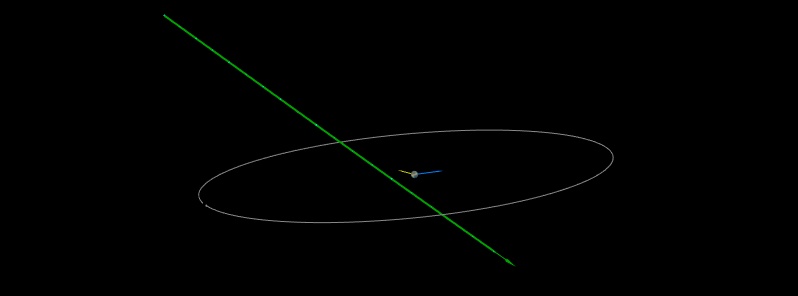Asteroid 2019 CN5 flew past Earth at 0.31 lunar distances

A newly discovered asteroid flew past Earth at a distance of 0.31 LD / 0.00079 AU (118 182 km / 73 435 miles) on February 11, 2019. This is the 6th known asteroid to flyby Earth within 1 lunar distance since the start of the year and first since January 27.
Asteroid 2019 CN5 belongs to the Apollo group of asteroids. It was first observed at Catalina Sky Survey on February 12, one day after it made a close approach to our planet.
2019 CN5's estimated diameter is between 7.3 and 16 m (23.9 – 52.5 feet). It flew past us at a speed (relative to the Earth) of 15.84 km/s at 07:23 UTC.
[ Ephemeris | Orbit Diagram | Orbital Elements | Mission Design | Physical Parameters | Close-Approach Data ]
| NEO | DATE / TIME UTC | DISTANCE LD | AU | Diameter | ||||
| 2019 CN5 | February 11 @ 07:23 UTC ± 00:03 | 0.31 | 0.00079 | 7.3 m – 16 m | ||||
| 2019 BZ3 | January 27 @ 23:29 ± < 00:01 | 0.13 | 0.00032 | 5.0 – 11 m | ||||
| 2019 BV1 | January 24 @ 20:53 ± < 00:01 | 0.35 | 0.00090 | 4.9 – 11 m | ||||
| 2019 BO | January 16 @ 01:13 ± 00:02 | 0.18 | 0.00046 | 6.6 – 15 m | ||||
| 2019 AE9 | January 12 @ 11:09 ± < 00:01 | 0.26 | 0.00067 | 9.9 – 22 m | ||||
| 2019 AS5 | January 8 @ 00:37 ± < 00:01 | 0.04 | 0.00010 | 0.95 – 2.1 m | ||||
References
Asteroid 2019 CN5 at Minor Planet Center; at CNEOS
Featured image: The green line indicates the object's apparent motion relative to the Earth, and the bright green marks are the object's location at approximately half hour intervals. The Moon's orbit is grey. The blue arrow points in the direction of Earth's motion and the yellow arrow points toward the Sun. Credit: Minor Planet Center

How does the recent frequency of neas compare with historical records – are these asteroids becoming more common?
Or is it simply a case of we are getting much better at detecting them?
regards
Peter
I wouldn’t call them historical records as we are still not at a point where we could say we have a reliable sky coverage. We are getting better and since 2005 NASA’s goal is to detect 90% of all NEOs larger than 140 m. In 2001 we knew for a total of 936 NEOs, at the end of 2010 – 7 564 and as of February 12, 2019, that number is 19 763. If we compare the first 45 days of detected <1LD NEAs in 2019 with 2018, 2018 is leading by 9.. or 15 vs 6. In the first 45 days of 2017, we detected only 4, in 2016 8, 2015 4...